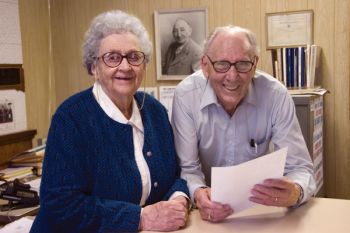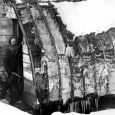The Gift of South Dakota
Subscriptions to South Dakota Magazine make great gifts!
Subscribe today — 1 year (6 issues) is just $29!
Milbank’s Newspaper Family
Editor’s Note: Clarence and Phyllis Justice were going strong as publishers of the Grant County Review in Milbank when we visited the newspaper in 2008. At the time, the paper had been in their family’s hands for almost 100 years. Not long after this story appeared, both Phyllis and Clarence developed health problems. They sold the Review to Debbie Hemmer and Holli Seehafer in October of 2013. Phyllis died in November 2013 and Clarence followed in October 2014. They will long be remembered as one of South Dakota’s pioneer publishing families.
Lucky is the town with a newspaper owned and edited by a spunky journalist who knows the community’s history and secrets, and even its very soul. By that standard, Milbank won the lottery when Bill Dolan bought the weekly Grant County Review in February of 1911.
He married Christine Olson a year later, and they had a daughter, Phyllis. Clarence Justice joined the family in 1955 when he married Phyllis. Christine’s sister, Victoria Olson, was also involved in the paper from 1915 to 1990, selling ads, gathering news, setting type and keeping books.
That’s basically the history of The Review to this date. The family has been in charge for the last 97 years. Portraits of both Bill and Phyllis hang in the South Dakota Newspaper Hall of Fame on the South Dakota State University campus in Brookings.
Bill Dolan was a young St. Thomas College graduate — a staunch Democrat and Catholic — when he arrived in Milbank from St. Paul, Minn. He couldn’t have known the tough competition he would face in a predominately Republican and Protestant community with competing newspapers.
At times, three newspapers fought over readership, advertising and printing. Milbank didn’t become a one-paper town until 1991, when the Herald Advance ceased publication. The Review and the Herald Advance had been lively competitors for over 100 years. “When it was gone, it was like playing tennis without a partner,” Phyllis says. “It took us a long time to adjust.”
“My dad had many other interests, and he might have sold the paper somewhere along the way, but my mother was really devoted to it, and neither she nor I would hear of selling,” says Phyllis. “When mother was on her deathbed at age 101 she asked me, ‘We still have the paper, don’t we?’”
Phyllis says both of her parents chose to spend money for needed printing equipment rather than for their own use. “No matter how little advertising dad had, he never cut back on news coverage,” she says. “Even in the Depression years he always put out a newsy paper, and he never failed to include a generous number of editorials. He was determined to make Milbank a better community.”
Though he often worked 80-hour weeks, he still found time to promote community and political projects and to enjoy hunting and fishing in the Glacial Lakes. For 12 years as a Democrat on the five-member state Board of Regents, he was instrumental in shaping the future of South Dakota’s public universities. On one occasion, press day at The Review was delayed while he helped to settle a student strike at Northern Normal and Industrial School (now Northern State University) in Aberdeen. Phyllis returned to Milbank in July of 1946 to join her father in the family enterprise and succeeded him as editor and publisher when he died in 1957. A journalism graduate of the University of Minnesota, she had worked at the Minneapolis Tribune, the Minneapolis Star Journal and the Mankato Free Press. She had also served as an assistant club director for the USO in the Seattle area during World War II, and later as public relations director for the National Catholic Community Service in Washington, D.C. No matter where she was working, she always furnished her dad with a weekly column that she’d started while in college.
When many readers couldn’t afford subscriptions in the 1930s and early 1940s, Phyllis’ dad continued to mail newspapers to them. After the hard times ended, he decided it was time to make everyone a paying customer again, so he sent Phyllis and her Aunt Victoria as collectors — door to door and farm to farm. Victoria and Phyllis would start out early in the morning after the week’s paper had been printed and mailed. They packed a thermos of coffee and lunch, and headed down country roads in an old Dodge, with the subscription list in the back seat.
Some subscribers hadn’t paid for a dozen years. On a good day, however, Victoria and Phyllis would go home with more than $100. They risked dog bites, and several times they were ordered to “get off the premises and never to send that dirty Democrat rag to them again.”
For a special issue commemorating the paper’s 125th anniversary in 2005, Phyllis wrote about her family’s involvement, but she also heralded the non-family staff, several of whom had been with the paper for over 50 years. And she explained how she met her husband and assistant publisher.
“Finding a capable printer who was willing to live in a small town was very difficult,” she wrote. “In 1952, dad placed a help wanted ad in the Minneapolis Tribune. Little did he suspect that he would get a call from a printer in Miller who was a regular reader of the Minneapolis paper. Dad was so impressed with the caller that he asked him to report for work on Monday.”
She recalled that her dad put down the phone and told her he’d hired a printer who had experience on dailies and weeklies in several states.
“What is his name?” Phyllis asked.
“Oh, I forgot to ask him,” her father replied. “But he is coming.”
Phyllis doubted the printer would show, but the following Monday a tall, slender young man was at work in the office when she arrived. She became Mrs. Clarence Dolan Justice just three years later, and the two have worked together ever since. By any standard, they are the First Couple of South Dakota newspapering.
In the 2005 anniversary issue, Phyllis, Clarence and the entire Review staff invited readers to a cake and ice cream open house with a full page advertisement that read, “It hasn’t always been a piece of cake, but it has been a labor of love.”
Republicans, Democrats, Independents, Protestants, Catholics, agnostics and others showed up to celebrate.
Editor’s Note: This story is revised from the March/April 2008 issue of South Dakota Magazine. To order a copy or to subscribe, call (800) 456-5117.











Comments
THE REAL QUESTION IS - "WHERE IS BERNIE"??? I HOPE HE IS BUSY SHOVELING SIDEWALKS AND DRIVEWAYS AND NOT SOMEPLACE GETTING TAN!!!